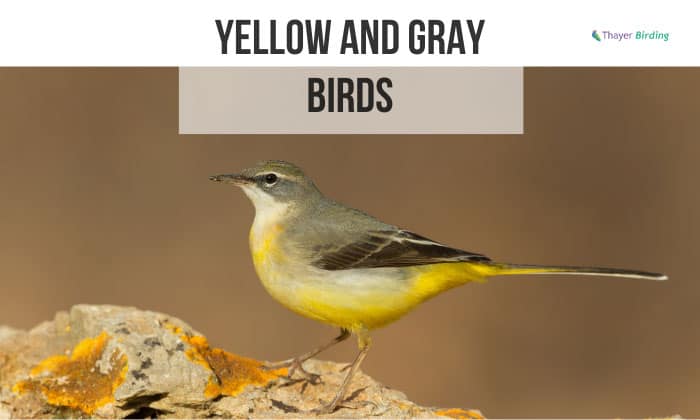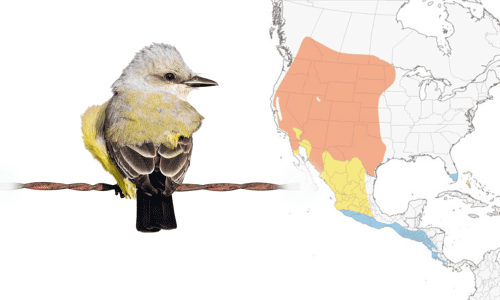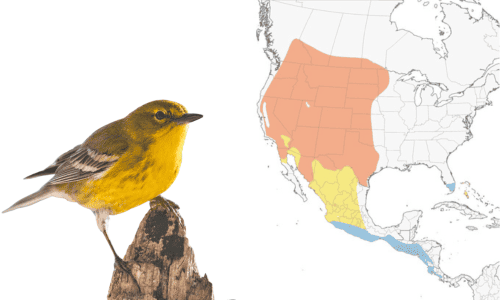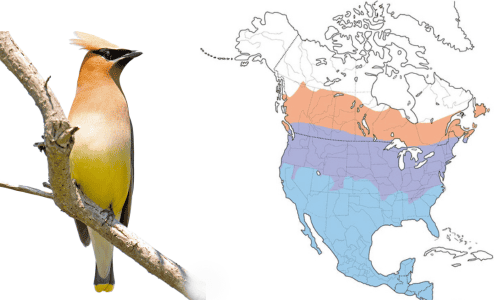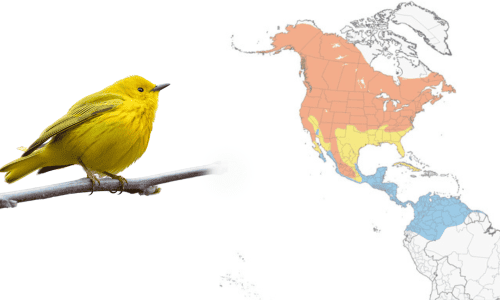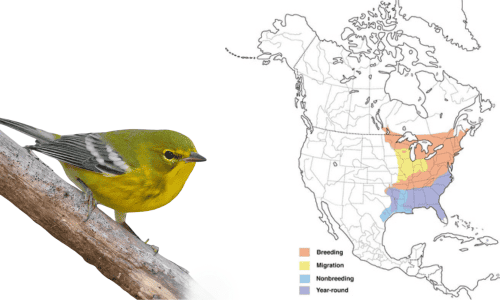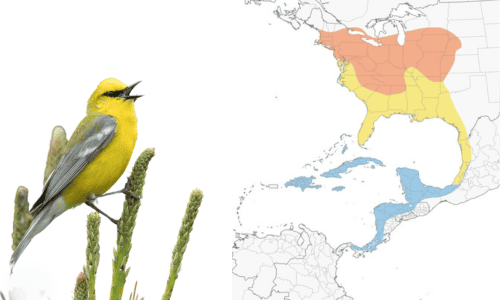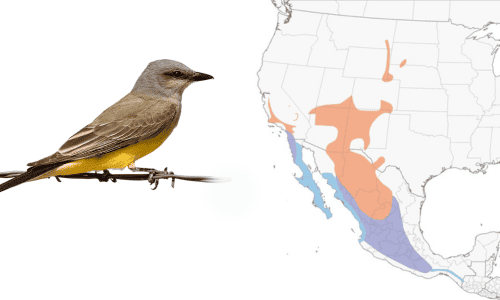Yellow and gray birds are more common than you think. There should be a handful of them you don’t know yet. Spotting these birds and identifying them are two things. You’ll need some handy knowledge and keen eyes.
Some common birds with this color combination are the Western kingbird, grey wagtail, Nashville warbler, tropical kingbird, and American yellow warbler. Dig a little deeper, and you’ll come across pine warbler, couch’s kingbird, and bananaquit.
We have a list of yellow birds with information about their notable features, unique characteristics, location, preferred habitat, and stunning photos. Are you ready? Read on.
Common Yellow and Gray Birds
1. Western Kingbird
Scientific Name: Tyrannus verticalis
Weight Range: 37 to 46 grams
Approximate Length: 20 to 24 centimeters
Wingspan: 38 to 41 centimeters
This bird has a pale gray head, bright yellow belly, and white chest and throat. Its distinctive black square-tipped tails are prominent when mid-air. Since the species are bulky flycatchers, they have heavy and straight bills used for hunting.
Western Kingbirds frequent roadside fences, utility lines, and any open habitats in the lowlands and valleys. You can spot them during summer in the western part of the United States. In winter, they migrate to Central America and Mexico, while others overwinter in South Florida.
This warbler species is territorial, aggressively defending its nests by fluttering its wings and using high vocal attacks that sound like squeaky toys. They will attack anything from humans to their pets that seem potentially threatening.
2. Grey Wagtail
Scientific Name: Motacilla cinerea
Weight Range: 15 to 23 grams
Approximate Length: 18 to 19 centimeters
Wingspan: 25 to 27 centimeters
Grey Wagtails are often confused with Yellow Wagtails. To tell them apart, look for the former’s yellow underside that stretches from the throat to the vent. Males, in particular, have a gray face, white mustache, and black throat, which can be observed during the breeding season. In contrast, the females sport a white chin and throat.
This bird species is widespread across the Palearctic region. A part of its population migrates and spends the winter in Asia and Africa. Grey Wagtail prefers freshwaters, farmlands, coastal areas, wetlands, towns, gardens, and urban areas.
If you ever come across a nest near fast-running rivers and streams, there’s a high chance it belongs to a Grey Wagtail. They have expanded their range thanks to the better water quality, allowing these birds to nest almost everywhere in the country.
3. Nashville Warbler
Scientific Name: Leiothlypis ruficapilla
Weight Range: 6.5 to 13.9 grams
Approximate Length: 11 to 13 centimeters
Wingspan: 17 to 20 centimeters
You can easily identify this bird by looking for its gray hood, which is present in both sexes. However, it should be noted that the females are paler than their male counterparts. In addition, the species have yellow undersides with white in their lower bellies. The white eye rings are also another notable feature of the Nashville Warbler.
This small grey bird got its name when ornithologist Alexander Wilson met the bird for the first time in Nashville, Tennessee, while the birds were migrating. Nashville Warblers commonly breed in open mixed woods and forest edges in the northeastern part of the United States and in Canada. In winter, you can find them in Mexico.
One thing that makes Nashville Warblers unique is using porcupine quills nest bedding. That aside, they also use shrubby tangles as a nesting place.
4. Tropical Kingbird
Scientific Name: Tyrannus melancholicus
Weight Range: 32 to 43 grams
Approximate Length: 18 to 23 centimeters
Wingspan: 38 to 41 centimeters
Tropical Kingbird is a grey bird with yellow belly. This powerful flycatcher with a long black bill and a large gray head. Their vivid yellow underparts and pale greenish-gray black make a stunning contrast.
This bird’s population is increasing and is widespread in all open and semi-open habitats in most tropic regions of America. That said, they prefer rural areas and towns with scattered trees and near water sources.
Out of the four kingbird species, the Tropical Kingbird is the most discrete. Despite their number, you’ll rarely see them in flocks.
5. Cedar Waxwing
Scientific Name: Bombycilla cedrorum
Weight Range: 32 grams
Approximate Length: 14 to 17 centimeters
Wingspan: 22 to 30 centimeters
Cedar Waxwing, like other waxwings, has a flat crest dropping over the back of their heads. To distinguish it from other birds, take note of its pale brown head, pale yellow bellies, narrow black eyes mask, red wing tip, and bright yellow tail tip, which is short and square. Males and females Cedar Waxwing are, for the most part, identical.
This bird with yellow tail tip can be observed all year in all kinds of woodlands, suburbs, and backyards of northern America. They are very social and travel in flocks.
Cedar Waxwings feed primarily on fruits, but they may also opt for insects as well. You can see them plucking in the air or coursing the water for insects.
6. American Yellow Warbler
Scientific Name: Setophaga petechia
Weight Range: 9 to 11 grams
Approximate Length: 12 to 13 centimeters
Wingspan: 16 to 20 centimeters
American Yellow Warbler, also called the yellow warbler, has a small body with even proportions and medium-length tails. Both sexes have yellow plumage all over, with males having reddish streaks in their underparts. They have the most number of yellow feathers than any warbler in North America!
Moreover, this warbler species has one of the most widely distributed nesting and breeding areas in North America. They prefer shrubby thickets and woodlands along wetlands, watercourses, and even mangrove forests.
You can hear male American Yellow Warblers sing their sweet songs on high perches of small trees and tall shrubs. They are restless creatures when it comes to foraging, hopping from one branch to another for insects and caterpillars.
7. Northern Parula
Scientific Name: Setophaga americana
Weight Range: 5 to 11 grams
Approximate Length: 11 to 12 centimeters
Wingspan: 16 to 18 centimeters
These wood warblers are the smaller species of North American migratory warblers. They have thin yet pointy bills, short tails, and plump bodies. During the summer—the breeding season, the males have prominent white eye crescents and blueish breast bands, which turn dull once winter comes.
Northern Parula is a migratory species, spending the winter in the northern part of Central America, southern Florida, and the West Indies. These birds are also common in eastern North America, breeding in humid woods, coniferous forests, and evergreen forests.
The flitting and hopping above forest and sub-canopy is one of the well-known behavior of Northern Parulas. They forage calmly, hovering on branches’ tips and leaves to search for insects that they dart out to catch amid flight.
Lesser-Known Yellow and Gray Birds
1. Prothonotary Warbler
Scientific Name: Protonotaria citrea
Weight Range: 12.5 grams
Approximate Length: 13 centimeters
Wingspan: 22 centimeters
This small yellow bird got its name “Prothonotary” from the Roman Catholic Church scribes wearing bright yellow hoods. It is a fitting name to describe their golden yellow plumage paired with their blue-gray wings and beady black eyes. There’s little difference between the sexes, except for the females’ slightly duller colors.
Prothonotary Warbler, which is also called swamp warbler, builds their nests in erect dead tree cavities. They inhabit wooded swamps and bottomland forests in the eastern United States and southeastern Ontario, breeding in wetlands with bay trees.
These warblers forage low for snails and insects. During the breeding season, they’ll drive away intruders by snapping their bills aggressively.
2. Pine Warbler
Scientific Name: Setophaga pinus
Weight Range: 9 to 15 grams
Approximate Length: 13 to 14 centimeters
Wingspan: 19 to 23 centimeters
Pine Warblers are known for their sturdy bodies, long tails with a central notch, and stout bills. They have yellow, black, and white coloring, with males having brighter yellow plumage than females. Both sexes have white bellies, olive green backs, and two white wing bars on their gray wings.
These birds are short-distance migrants; thus, their population remains within the southern United States even in the winter. As their name suggests, these birds inhabit pine trees, especially during the breeding season.
Pine Warblers are sluggish compared to other warbler species. They forage for food around pinewoods and regularly visit bird feeders with soft foods and suet.
3. Blue-winged Warbler
Scientific Name: Vermivora chrysoptera
Weight Range: 8.5 grams
Approximate Length: 11.4 to 12.7 centimeters
Wingspan: 17 to 19.5 centimeters
At first glance, you might mistake this bird for a Prothonotary Warbler because of the similar gray wings. What makes the Blue-winged Warbler different is its two white wing bars and thin dark eyeline. Female Blue-winged Warblers share the same features as the males but with a duller color and less yellow.
These blue-winged birds reproduce in the eastern part of the United States and migrate to Central America, Mexico, and the Caribbean during winter. They prefer forest edges, abandoned fields, brushy hillsides, overgrown pastures, and streams. In the past years, they are found to be expanding their territories to the north, trespassing on Golden-winged Warbler’s area.
Blue-winged Warblers are skilled at gleaning buds and leaves with their sharp and pointed bills. They are also known as acrobatic feeders since they sometimes hang upside-down while hunting for food.
4. Yellow-headed Warbler
Scientific Name: Teretistris fernandinae
Weight Range: 6 to 18.5 grams
Approximate Length: 13 centimeters
Yellow-headed Warblers are gray birds with yellow heads, gray to grayish-white underparts, and hints of olive on their crown and nape. There’s no difference to distinguish the males from their female counterparts.
These birds are native to far western Cuba, near Cayo Cantiles and Isla de la Juventud, where they are an all-year resident. They prefer scrubby thickets in dry forests, lowland moist forests, and almost any type of forest as long as they have undisturbed undergrowth.
Yellow-headed Warblers can only make short flights within their range; thus, they are not migrant birds. They forage in flocks and glean foliage and branches for insects.
5. Couch’s Kingbird
Scientific Name: Tyrannus couchii
Weight Range: 40 grams
Approximate Length: 20 to 24 centimeters
Wingspan: 22.86 centimeters
This gray bird with yellow breast and belly, also has a white throat, pale gray head, and black bills and legs. The Couch’s Kingbird is a passerine flycatcher with a large body, head, straight bill, and long wing and tail.
Couch’s Kingbirds inhabit Mexico, southern Texas, and along the Gulf Coast. These birds don’t migrate. They winter in wooded areas with openings and lots of edges, always on the lookout for flying insects, fruits, and berries.
Similar to most flycatchers, they can skillfully fly and capture an insect mid-flight with their strong bills. Whether hovering or perched, plucking their food is not a problem at all!
6. Bananaquit
Scientific Name: Coereba flaveola
Weight Range: 5.5 to 19 grams
Approximate Length: 10 to 13 centimeters
Wingspan: 19.05 centimeters
One can easily identify this bird with its black bills that are curved and pointed downward. Other notable features are the white eyebrow, black crown, black head sides, pale gray to white throat, dark gray to almost black upper parts, yellow chest, belly, and backside. Both sexes share the same color pattern and characteristics.
These birds are native to the tropical parts of South America, the Caribbean, and Mexico. You can find them in humid evergreen forests, woodland edges, crops, city parks, and orchards. They have grown to adapt to human environments, becoming tame and visiting gardens.
Bananaquits are active nectarivores, often creeping on flowering trees to search for blossoms. They also feed on small insects and fruits.
7. Cassin’s Kingbird
Scientific Name: Tyrannus vociferans
Weight Range: 45 grams
Approximate Length: 21 to 23 centimeters
Wingspan: 41 centimeters
Cassin’s Kingbird is sometimes falsely identified as the Western Kingbird since they share an almost similar appearance. But if you look closely, you’ll see that the former is larger, has darker gray upper parts, and a thin white edge located in the distal tail end.
These assertive birds mostly occupy south-central Mexico. They prefer the dry open country of California and along the eastern Rocky Mountains during the summer. However, a small population of the species also reside in the American Southwest, which would migrate to Mexico during the winter.
Cassin’s Kingbird is the noisiest of the kingbird species. They usually sing after dusk; thus, they are often mistaken as night birds. Their diet consists mostly of insects, although berries and fruits are also acceptable.
Conclusion
If you did not know the names of yellow birds back then, you can now recognize most of them. You can also share the knowledge you got from us with your family, friends, and anyone interested in types of yellow birds!
Have you seen any of the yellow and gray birds on our list? Maybe birds with yellow wings or with red cheeks? How was your encounter with them? Comment about them below, we always love hearing from our readers.

George and I became friends after a birdwatching trip with our new group. And we have been enjoying every adventure together. When he told me the idea of establishing a site that shares our experiences and fun, I immediately agreed. After trials and errors, here we have Thayerbirding.


